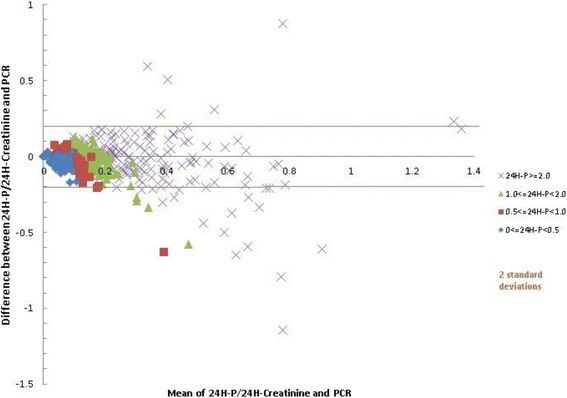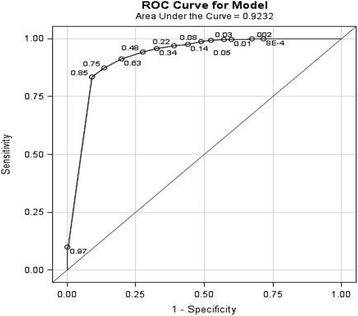Utility of untimed single urine protein/creatinine ratio as a substitute for 24-h proteinuria for assessment of proteinuria in systemic lupus erythematosus
- PMID: 26497948
- PMCID: PMC4619322
- DOI: 10.1186/s13075-015-0808-x
Utility of untimed single urine protein/creatinine ratio as a substitute for 24-h proteinuria for assessment of proteinuria in systemic lupus erythematosus
Abstract
Introduction: In this study, we determined: (1) the utility of an untimed sample of urine protein/creatinine ratio (PCR) as a screening test for proteinuria, (2) its ability to accurately measure proteinuria, and (3) cutoff values for PCR predicting protein content in a 24-h urine collection sample (24hP) of 0.5, 1.0, and 2.0 g/day.
Methods: Analysis was performed on data from a single lupus cohort (2008-2014). Proteinuria was measured in a 24hP and with PCR. On the basis of 24hP, samples were divided into 4 groups: group 1, <0.5 g/day; group 2, 0.5-0.99 g/day; group 3, 1-1.99 g/day; and group 4, ≥2 g/day. To determine the validity of PCR in screening for proteinuria, the Pearson correlation coefficient was determined for the urine samples with normal PCR (<0.05 g/mmol) and normal 24hP (<0.5 g/day). The sensitivity, specificity, positive predictive value (PPV), and negative predictive value (NPV) of PCR were calculated. To determine the ability of PCR to accurately measure the level of proteinuria, in addition to the correlation between 24hP and PCR, agreement was determined by intraclass correlation coefficient, concordance correlation coefficient, and Bland-Altman plot between 24hP/24hC and PCR. The best cutoffs for PCR predicting a 24hP of 0.5, 1.0, and 2.0 g/day were determined with the receiver operating characteristic curve.
Results: The correlation of the samples with normal PCR as well as 24hP (n = 552) was 0.29 (p < 0.0001). PCR sensitivity and specificity against 24hP were 91 % and 83 %, respectively. The PPV was 82.5 %, and the NPV was 91.4 %. The correlation for all samples (n = 1233) was high, but low to moderate for groups 1, 2, 3, and 4. The agreement for all samples was appropriate but poor for groups 1, 2, 3, and 4. PCR cutoffs for 24hP of 0.5, 1.0, and 2.0 g/day were 0.08, 0.16, and 0.35 g/mmol, respectively.
Conclusions: PCR can be used as a screening test for proteinuria, and the best cutoff value to predict a 24hP of 0.5 g/day is 0.08 g/mmol (800 mg/g). The accurate level of proteinuria should be measured by the gold standard test, 24hP.
Figures



Similar articles
-
Urine protein-to-creatinine ratio in an untimed urine collection is a reliable measure of proteinuria in lupus nephritis.Rheumatology (Oxford). 2007 Apr;46(4):649-52. doi: 10.1093/rheumatology/kel360. Epub 2006 Oct 25. Rheumatology (Oxford). 2007. PMID: 17065189
-
Comparison of 24-hour urinary protein and protein-to-creatinine ratio in the assessment of proteinuria.Saudi J Kidney Dis Transpl. 2009 May;20(3):443-7. Saudi J Kidney Dis Transpl. 2009. PMID: 19414948
-
The accuracy of spot urinary protein-to-creatinine ratio in confirming proteinuria in pre-eclampsia.Aust N Z J Obstet Gynaecol. 2012 Apr;52(2):179-82. doi: 10.1111/j.1479-828X.2011.01409.x. Epub 2012 Feb 15. Aust N Z J Obstet Gynaecol. 2012. PMID: 22335428
-
Spot urine protein-to-creatinine ratio compared with 24-hour urinary protein in patients with kidney transplant.Exp Clin Transplant. 2014 Aug;12(4):300-3. Exp Clin Transplant. 2014. PMID: 25095707
-
Urinary chemistry of the normal Sprague-Dawley rat.Urol Res. 1993;21(5):309-12. doi: 10.1007/BF00296826. Urol Res. 1993. PMID: 8279085 Review. No abstract available.
Cited by
-
Serum Albumin as an Early Predictor of Proteinuria Recovery in Lupus Nephritis.Mediterr J Rheumatol. 2025 May 14;36(2):242-250. doi: 10.31138/mjr.040924.sai. eCollection 2025 Jun. Mediterr J Rheumatol. 2025. PMID: 40757132 Free PMC article.
-
High incidence of proliferative and membranous nephritis in SLE patients with low proteinuria in the Accelerating Medicines Partnership.Rheumatology (Oxford). 2022 Nov 2;61(11):4335-4343. doi: 10.1093/rheumatology/keac067. Rheumatology (Oxford). 2022. PMID: 35212719 Free PMC article.
-
Correlation of urine protein/creatinine ratios to 24-h urinary protein for quantitating proteinuria in children.Pediatr Nephrol. 2020 Mar;35(3):463-468. doi: 10.1007/s00467-019-04405-5. Epub 2019 Dec 7. Pediatr Nephrol. 2020. PMID: 31813022
-
Limited Reliability of the Spot Urine Protein/Creatinine Ratio in the Longitudinal Evaluation of Patients With Lupus Nephritis.Kidney Int Rep. 2018 Apr 27;3(5):1057-1063. doi: 10.1016/j.ekir.2018.04.010. eCollection 2018 Sep. Kidney Int Rep. 2018. PMID: 30197972 Free PMC article.
-
Correlation between spot and 24h proteinuria: Derivation and validation of equation to estimate daily proteinuria.PLoS One. 2019 Apr 2;14(4):e0214614. doi: 10.1371/journal.pone.0214614. eCollection 2019. PLoS One. 2019. PMID: 30939176 Free PMC article.
References
MeSH terms
Substances
LinkOut - more resources
Full Text Sources
Other Literature Sources
Medical

